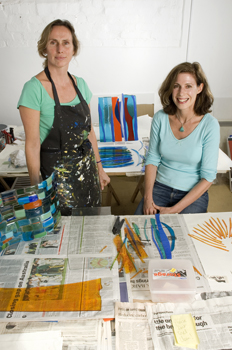|
A brief history of glass fusing
Glass fusing is a process where
pieces of glass are joined together by melting
them in a kiln to a temperature of around 800°C.
Pieces of compatible glass are selected, cut and
sometimes ground into shape and then placed in
a kiln. The glass heats up slowly and then faster
and the glass softens, becomes hotter and more
fluid and then sticks together. It eventually cools
slowly and then will be solid. A second firing
with the fused glass piece balanced over or inside
a mould is called slumping.
The first fusing and kiln casting
(a process which also uses a kiln to melt and shape
glass pieces placed inside a mould) was produced
by the ancient Mesopotamians in the 2nd
millennium B.C. These processes evolved
from
ceramic and metal working techniques and glass
was considered a precious material alongside
silver and gold. The Ancient Egyptians also developed
the process.
By the latter half of the second millennium they
became proficient in fusing the other glass techniques.
Greeks and Romans continued to improve the technique.
The development of kiln formed techniques were
short lived due to the emergence of a new technique,
glass blowing. This became popular as it could
be repeated easily and was considered more efficient
and cheaper. It became the prevalent technique
for glass workers and spread throughout the Roman
Empire.
By the 2nd and 3rd Century AD
the warm glass techniques were almost forgotten.
They were re-discovered
in Europe. particularly in France in the 19th
century . Bullseye Glass Co. was formed in Oregan
in America
in
1974
and
has developed glass fusing techniques further.
They were the leaders in research and developed
compatible glass especially for fusing.
|
|
 |